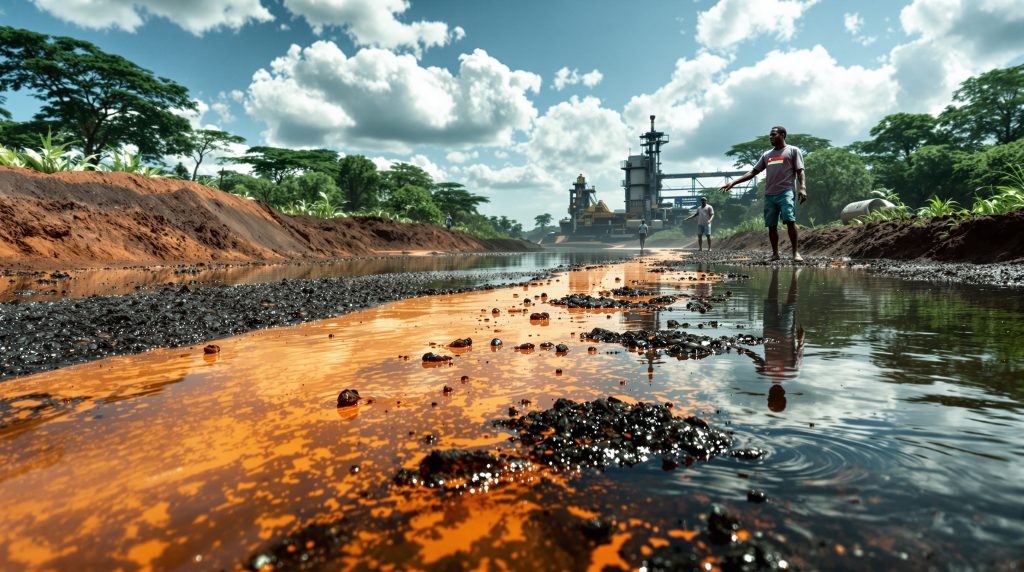Zambian Mine Spill Compensation: The Fight for $420 Million
What Caused the Zambian Copper Mine Disaster?
In February 2025, a catastrophic environmental disaster struck Zambia when approximately 1.5 million tonnes of highly acidic waste was released from a Chinese-operated copper mine. The incident, now considered one of Africa's worst mining disasters in recent history, contaminated local water sources, soil, and agricultural lands across several communities.
According to independent environmental assessments, the toxic spill contained dangerous levels of heavy metals including cyanide, arsenic, copper, zinc, lead, chromium, and cadmium. These contaminants pose severe health risks to exposed populations and devastating consequences for local ecosystems.
The scale of the disaster was initially downplayed, with official reports significantly underestimating the volume of hazardous materials released. Bloomberg News later reported that the spill released "30 times more poisonous material than officially reported," highlighting the severity of the incident.
Environmental experts have confirmed that approximately 900,000 cubic meters of toxic tailings remain in the environment, creating ongoing contamination concerns. The presence of these materials continues to threaten water supplies, agricultural productivity, and human health in affected areas.
Several foreign embassies issued travel advisories following the disaster, warning citizens to avoid the affected region due to environmental and health concerns. These warnings came after independent water testing confirmed dangerous levels of contamination in local water sources.
How Are Communities Affected by the Toxic Spill?
The Kalusale community, comprising 47 households, represents one of the most severely impacted areas from the spill. Residents have reported a range of health issues directly linked to exposure to contaminated water and soil. Common symptoms include skin irritations, respiratory problems, and gastrointestinal illnesses.
Beyond immediate health concerns, the contamination has devastated local livelihoods. Agricultural lands in the region have become unusable, leaving farmers without income sources. Fishing activities in local waterways have also ceased due to contamination, further impacting food security and economic stability.
Environmental health specialists warn that exposed populations face potential long-term health risks including organ damage, birth defects, and increased cancer risk. These chronic health concerns may not manifest fully for years or decades, complicating assessment of the disaster's true human impact.
Access to clean drinking water remains a critical challenge for affected communities. Many households now rely on water delivered by tanker trucks, creating dependency and increasing living costs for already vulnerable populations.
Mental health impacts have been largely overlooked in official response efforts. Community members report significant psychological distress stemming from displacement, economic uncertainty, and ongoing health concerns related to the contamination.
Why Is $420 Million Being Demanded in Compensation?
The total compensation demand of $420 million represents what legal representatives describe as the minimum amount needed to address the disaster's devastating impacts. This figure encompasses both immediate remediation needs and long-term support for affected communities.
The compensation package is divided into two main components: $220 million sought for the 47 households in the Kalusale community by legal firm Malisa & Partners, and $200 million requested by Malambo & Co. to establish an emergency fund for other victims in the broader region.
Compensation categories include:
- Relocation costs for families whose homes and lands are no longer habitable
- Comprehensive medical screening and treatment programs for exposed individuals
- Long-term health monitoring to identify and address emerging health concerns
- Livelihood restoration programs to replace lost income sources
- Environmental remediation to remove toxic materials from soil and water
- Psychological support services for affected community members
The $420 million figure was calculated based on international precedents for similar environmental disasters. Legal representatives point to cases in Brazil, Indonesia, and Papua New Guinea where mining companies provided substantial compensation for environmental damage and human suffering.
Environmental economists note that the full economic cost of the disaster likely exceeds even this substantial compensation demand when long-term health impacts, ecosystem damage, and reputational harm to the region are considered.
Who Is Responsible for the Environmental Disaster?
Sino Metals Leach Zambia, a Chinese state-owned enterprise, operates the mine responsible for the toxic spill. The company's operational practices and emergency response protocols have come under intense scrutiny following the disaster.
Initial response from Sino Metals focused on minimizing the incident's severity rather than addressing its impacts. The company terminated its contract with the environmental assessment firm that produced the first comprehensive analysis of the spill, citing disputed methodology but raising concerns about transparency.
The company has made initial compensation payments ranging from $17 to $2,000 to some affected individuals. These payments came with legal agreements designed to release Sino Metals from further liability, a practice that legal experts have criticized as potentially coercive given the power imbalance between the corporation and affected individuals.
Regulatory oversight failures have emerged as a significant factor in the disaster. Questions remain about how the mine was permitted to operate with apparently inadequate safety measures and emergency response protocols in place.
The Chinese government's role as the ultimate owner of Sino Metals adds diplomatic complexity to accountability efforts. International observers note that China's significant investment in Zambian infrastructure and mining decarbonisation operations creates potential conflicts of interest for Zambian regulatory authorities.
What Legal Strategies Are Being Used in the Compensation Battle?
Two prominent legal firms are spearheading the compensation battle on behalf of affected communities. Malisa & Partners Legal Practitioners represents the Kalusale community, while Malambo & Co. represents other affected individuals throughout the region.
Both firms have filed formal compensation demands against Sino Metals, challenging the adequacy of initial settlement agreements. They argue that these early agreements, which included payments of $17-$2,000, were:
- Inadequate compared to actual damages suffered
- Potentially coercive given victims' immediate needs for medical care and basic necessities
- Executed without full disclosure of health risks and environmental impacts
- Signed without proper legal representation for affected individuals
Legal experts suggest that these initial settlements could be invalidated in court based on principles of unconscionability, undue influence, and lack of informed consent. International human rights standards regarding environmental justice provide additional support for these challenges.
The legal teams are pursuing multiple simultaneous strategies, including:
- Direct negotiation with Sino Metals for comprehensive compensation
- Regulatory complaints to Zambian environmental authorities
- Potential international arbitration if domestic remedies prove inadequate
- Human rights complaints to international monitoring bodies
- Coordination with international environmental justice organizations
These parallel approaches aim to maximize pressure on both Sino Metals and Zambian regulatory authorities to address the disaster's impacts comprehensively. Similar strategies were recently employed in a class action lawsuit against mining companies in other regions.
How Has the Zambian Government Responded to the Crisis?
The Zambian government's response to the disaster has evolved significantly over time. Initial statements minimized the spill's severity, with officials suggesting that impacts would be limited and temporary. This position shifted as independent testing confirmed widespread contamination and international attention increased.
Current government statements acknowledge the disaster's severity but emphasize the need for cooperation with Sino Metals rather than punitive measures. This approach has drawn criticism from environmental advocates who argue that stronger enforcement actions are necessary.
Regulatory agencies have increased monitoring activities in the affected region but face significant resource constraints. Testing capacity, technical expertise, and enforcement mechanisms all present challenges for effective government response.
The disaster has prompted calls for comprehensive reform of mining regulations in Zambia. Environmental protection organizations advocate for:
- Stricter environmental impact assessment requirements
- More frequent and rigorous inspections of mining operations
- Higher financial assurance requirements for potential remediation
- Increased penalties for environmental violations
- Greater transparency in mining permitting and oversight
International diplomatic considerations complicate the government's response. China represents Zambia's largest foreign investor and a critical economic partner, creating potential conflicts between environmental protection, compensation for victims, and maintaining positive bilateral relations.
What Are the Long-Term Environmental Remediation Challenges?
Removing approximately 900,000 cubic meters of toxic tailings presents enormous technical and financial challenges. Environmental engineers estimate that comprehensive mine reclamation could take 5-10 years and require specialized equipment not currently available in Zambia.
Contaminated water sources present particularly complex remediation challenges. Groundwater contamination can persist for decades and spread far beyond the initial spill area, affecting communities not immediately impacted by the disaster.
Agricultural land restoration requires extensive soil testing, potential topsoil replacement, and specialized remediation techniques to address heavy metal contamination. Without proper remediation, these lands may remain unusable for generations.
Ecosystem recovery timeframes vary significantly by habitat type and contamination level. Aquatic ecosystems typically face the most severe and persistent impacts from mining contamination. River systems may require decades to recover even with active remediation efforts.
The remediation process itself presents potential risks if not properly managed. Disturbing contaminated sediments can release additional toxins, and improper disposal of removed materials could create new contamination sites if waste management solutions are not carefully implemented.
Environmental Impact Assessment: "Complete ecosystem recovery may require 30+ years even with aggressive remediation. Without proper intervention, permanent damage to local water systems is likely." – Environmental Protection Council of Zambia
How Does This Case Impact International Mining Standards?
The Zambian mine spill has focused international attention on environmental standards in the global mining industry, particularly operations in developing nations. Industry analysts suggest the case could accelerate the adoption of more stringent international standards.
Investor pressure represents a significant driver for improved practices. Following the disaster, several major investment funds announced enhanced environmental, social, and governance (ESG) screening for mining investments, with particular attention to tailings management and emergency response capabilities.
Transparency requirements are likely to increase across the industry. Several mining industry associations have called for standardized reporting of environmental risks, incidents, and remediation efforts to rebuild public trust.
Corporate accountability mechanisms are evolving in response to disasters like the Zambian spill. Legal experts note increasing willingness by courts in multiple jurisdictions to hold parent companies accountable for environmental damages caused by subsidiaries or contractors.
The case highlights disparities in environmental protection between developed and developing nations. Environmental justice advocates argue that mining companies should maintain consistent standards regardless of local regulatory requirements, rather than applying lower standards in regions with less robust enforcement. This is particularly relevant following the recent Namibian mining halt which was triggered by similar environmental concerns.
What Can Affected Communities Expect Moving Forward?
Resolution of compensation claims will likely take several years given the complexity of the case and the number of affected individuals. Legal experts suggest that initial settlements may be reached for some aspects of the claims while litigation continues on others.
Interim relief measures remain critically important while formal compensation processes advance. Humanitarian organizations advocate for immediate provision of:
- Clean drinking water supplies
- Medical screening and treatment for affected individuals
- Temporary housing for displaced families
- Emergency income support for those who lost livelihoods
- Psychological support services
Community participation in remediation planning represents a key demand from affected populations. Environmental justice principles emphasize that those most impacted by contamination should have meaningful input into recovery planning and implementation.
Long-term monitoring programs will be essential regardless of compensation outcomes. Health experts recommend at least 20 years of regular screening for exposed individuals to identify and address emerging health concerns related to toxic exposure.
Recovery prospects for the region depend significantly on the comprehensiveness of remediation efforts. Without thorough cleanup, communities may face permanent displacement and irreversible ecosystem damage.
FAQ: Zambian Mine Spill Compensation Claims
What specific health risks do the toxic chemicals pose?
The contaminants released in the spill can cause both acute and chronic health effects. Heavy metals like lead and arsenic can damage multiple organ systems, while cyanide exposure can be immediately life-threatening. Long-term risks include kidney and liver damage, neurological disorders, reproductive issues, and increased cancer risk.
How are compensation amounts calculated for environmental disasters?
Compensation calculations typically consider immediate damages (property loss, medical costs), ongoing impacts (health monitoring, lost income), and future projections (long-term health effects, ecosystem recovery costs). International precedents from similar disasters provide benchmarks for appropriate compensation levels.
Can victims who signed early settlements still pursue claims?
Legal experts suggest that early settlement agreements could be challenged based on several legal principles, including unconscionability, coercion, and lack of informed consent. Courts may invalidate these agreements if they find that victims were not fully informed of their rights or the extent of damages when signing.
What role are international organizations playing in the response?
Several international organizations are monitoring the situation, including UN environmental agencies, human rights monitoring bodies, and specialized NGOs focused on mining impacts. These organizations provide technical assistance, independent assessment, and advocacy support for affected communities.
How does this compare to other mining disaster compensation cases?
The $420 million compensation demand falls within the range established by other major mining disasters globally. The 2015 Samarco dam collapse in Brazil resulted in a $6.1 billion settlement, while the Ok Tedi mine in Papua New Guinea led to a $500 million compensation agreement. Smaller incidents have typically resulted in settlements of $50-200 million depending on impact severity.
Further Exploration
Readers interested in learning more about mining-related environmental incidents and compensation cases can explore educational content from reputable industry publications. Understanding the technical, legal, and social dimensions of these complex cases provides valuable context for evaluating the Zambian situation and similar environmental challenges globally.
Want to Stay Ahead of the Next Major Mining Discovery?
Discover why historic mineral discoveries can generate substantial returns by exploring Discovery Alert's dedicated discoveries page, where the proprietary Discovery IQ model delivers real-time alerts on significant ASX mineral discoveries, giving you an immediate market advantage.




